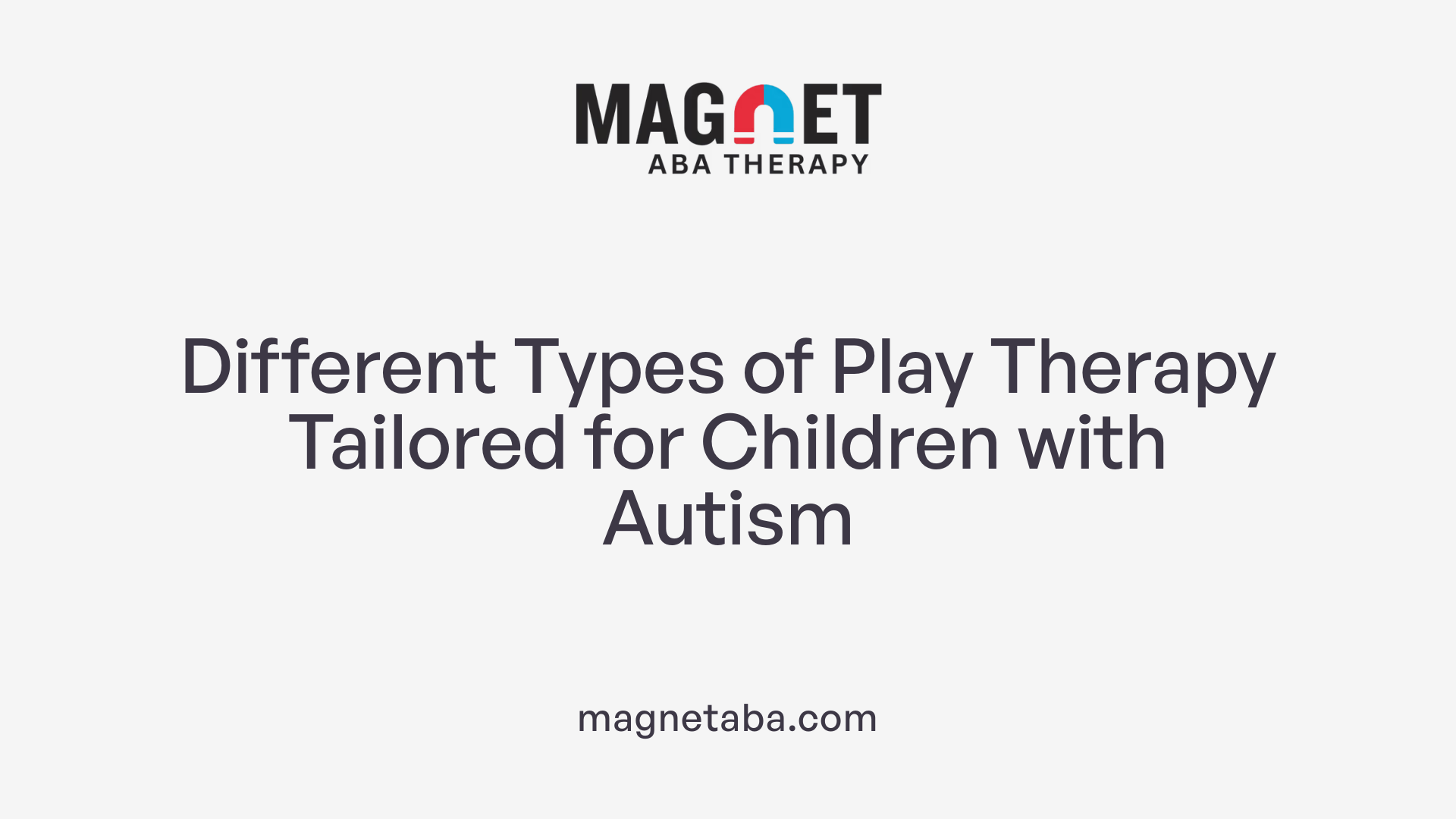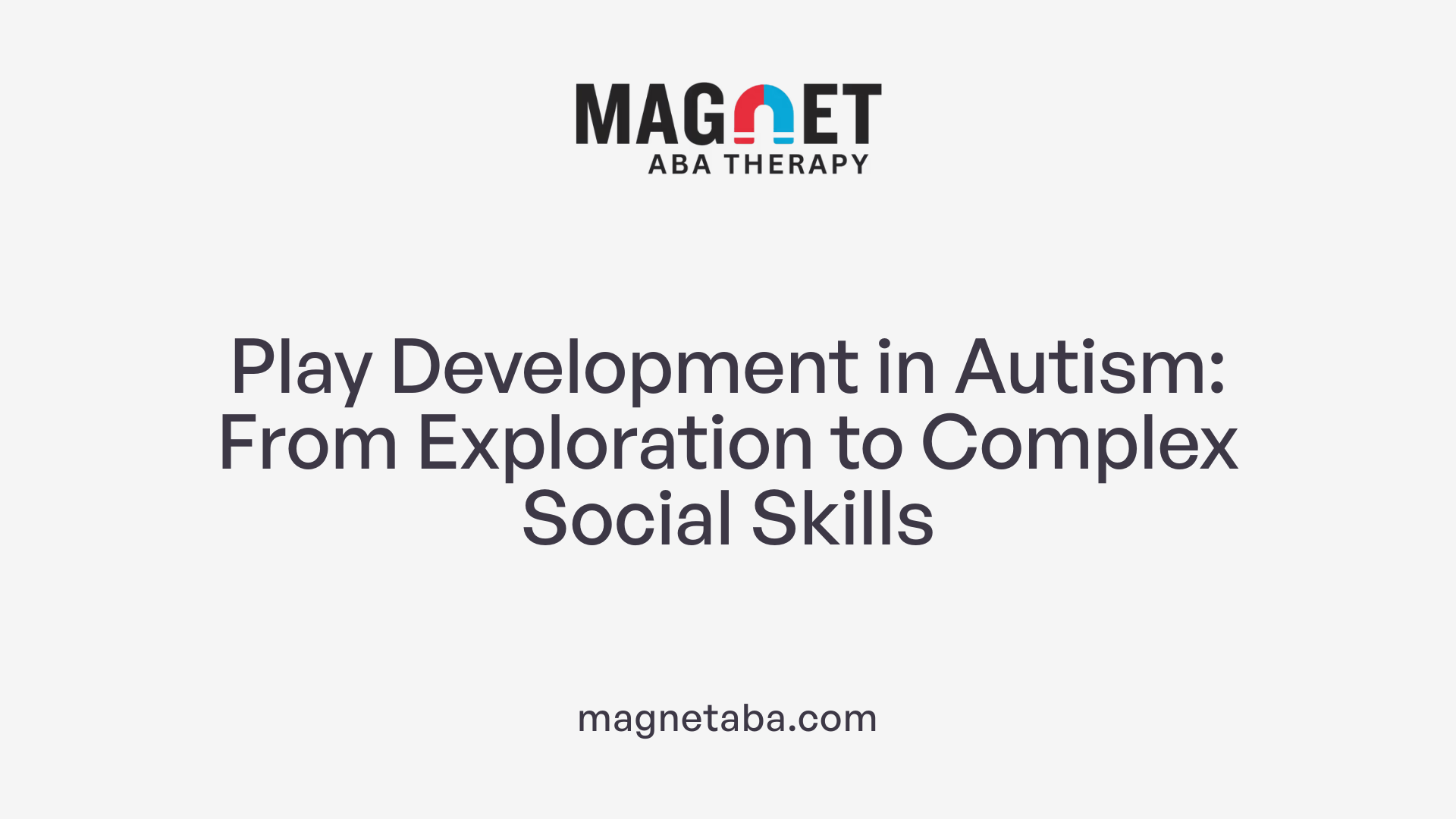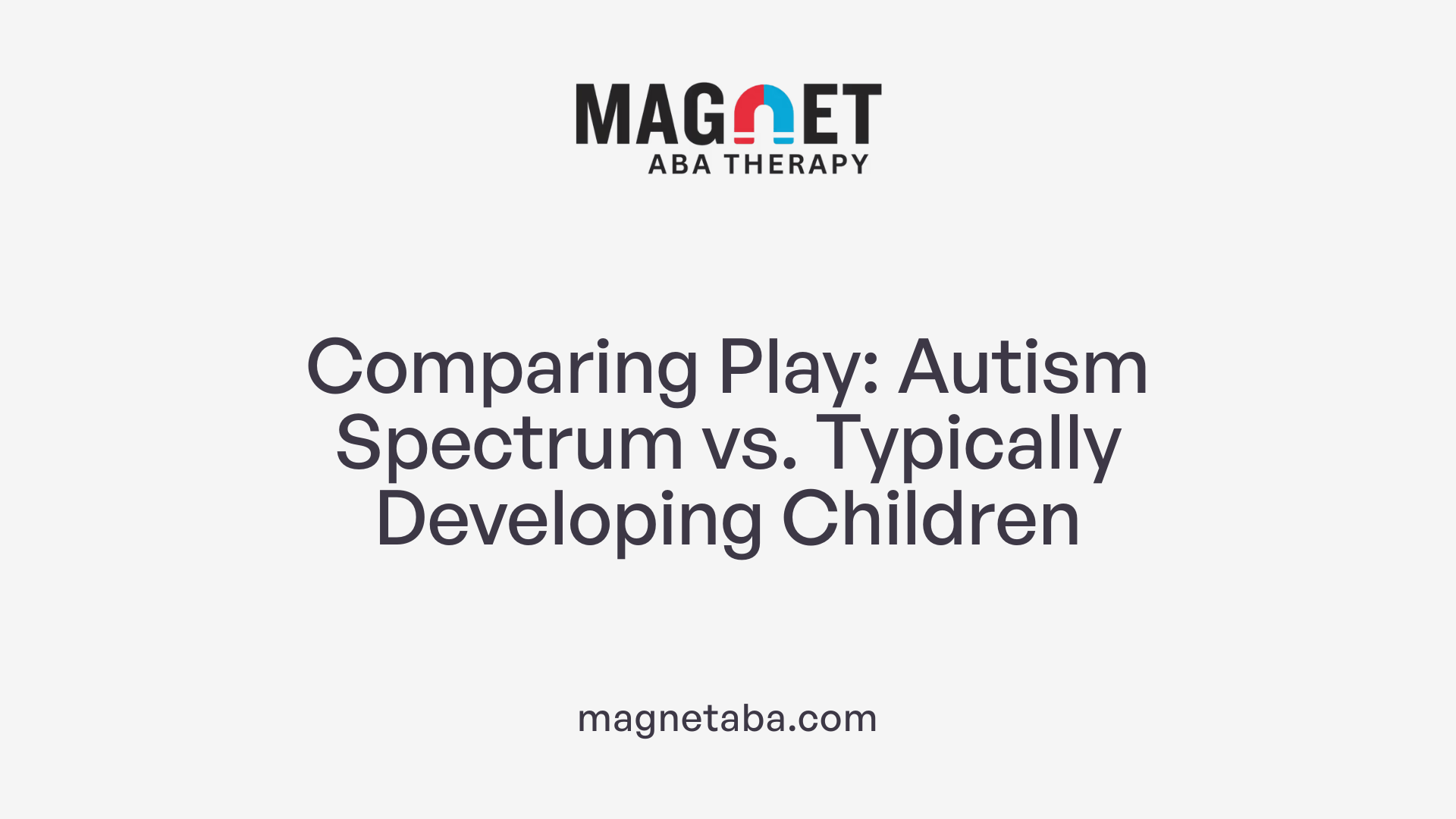Understanding the Power of Play in Autism Treatment
Play is a fundamental aspect of childhood development, serving as a vital tool in autism treatment. It promotes neural connectivity, enhances communication skills, and fosters social-emotional growth. Incorporating structured and functional play activities into therapy provides a natural and motivating environment for children with autism to develop essential life skills.
Defining Play Therapy in Autism Treatment

What is play therapy for autism?
Play therapy for autism is a child-centered approach that harnesses the natural language of children—play—to foster development and healing. This method involves engaging children with toys, pretend scenarios, and creative activities like art to help them express their feelings and needs comfortably. It creates a safe space where children can explore emotions, practice social skills, and improve communication.
Children with autism often encounter difficulties in adaptive behavior, social interaction, and verbal expression. Play therapy addresses these challenges by encouraging children to interact in a relaxed, engaging environment. Through various play activities, children learn to navigate social cues, develop emotional regulation, and build relationships.
Different types of play therapy
There are several forms of play therapy tailored for children with autism, each focusing on specific developmental goals:
| Type of Play Therapy | Focus Area | Description |
|---|---|---|
| Child-centered play | Emotional expression | Plays focus on child-led interactions, promoting emotional and social growth. |
| Floortime | Social skills & regulation | Emphasizes following the child's interests to build core social and emotional skills. |
| Sensory integration | Sensory processing | Uses sensory-rich activities to help children manage sensory sensitivities and integrate sensory input. |
| Structured play | Learning routines & skills | Incorporates planned activities to teach specific skills like turn-taking and problem-solving. |
Each approach is adapted to meet the child's unique developmental profile. When carefully implemented by trained therapists, these methods can enhance social competence, reduce problematic behaviors, and nurture independence.
While research continues to evaluate the relative efficacy of different types, evidence suggests that early and consistent play therapy can support brain development. It encourages neural plasticity and connectivity, resulting in positive neurobiological changes such as increased levels of brain-derived neurotrophic factor (BDNF) and neurotransmitter activity.
Overall, integrating play into autism treatment not only makes therapy more engaging but also facilitates natural development across cognitive, emotional, and social domains.
The Neurobiological Impact of Play in Autism

How play influences brain development
Play is fundamental to brain development, especially for children with autism. It activates all areas of the brain involved in cognition, emotion, and sensory processing. Through play, neural connections are strengthened, supporting brain plasticity—the ability of the brain to adapt and reorganize itself. This process is crucial during early childhood when the brain is most receptive to learning.
Engaging in play helps develop neural pathways that enhance learning, emotional regulation, and sensory integration. For children with autism, play can stimulate underdeveloped regions and promote better neural connectivity, leading to improvements in focus, flexibility, and social understanding.
Neurobiological benefits of play therapy
Play therapy, specifically tailored for children with autism, can induce positive changes in brain structure and function. It has been shown to increase levels of brain-derived neurotrophic factor (BDNF), a protein that supports neuron growth and survival. Additionally, play therapy boosts neurotransmitter activity, which enhances communication between neurons.
These neurobiological improvements translate to better behavioral outcomes. Enhanced neural plasticity allows children to acquire new skills more effectively, including social interaction, communication, and problem-solving. The therapy not only addresses behavioral challenges but also promotes brain health, making play an essential component of intervention for children with autism.
Overall, the strategic use of play, especially early and consistent engagement, can foster meaningful neurodevelopmental changes. This supports children’s growth and contributes to a higher quality of life by integrating developmental progress with biological resilience.
Developmental Milestones and Play Progression

Stages of Play Development
Play development generally follows a predictable sequence, moving from simple, instinctive actions to complex, symbolic activities. Early in life, infants engage in exploratory or exploratory play, often touching, grabbing, and mouthing objects to understand their environment. As they grow, children transition into functional or relational play, where they use objects as intended—like stacking blocks or rolling cars.
From around 18 months, children begin to partake in pretend or symbolic play, which involves using objects to represent other items or engaging in make-believe scenarios. By age 2 to 3, kids often participate in group play and work on completing specific play scenarios, fostering social skills and cooperation.
Between ages 3 and 4, children typically engage in more complex peer interactions, including role-playing, sharing, and participating in structured group activities.
How Children with Autism Compare to Typically Developing Children
Children with autism spectrum disorder (ASD) often show delays or differences in this play progression. They tend to have fewer opportunities with symbolic play, especially in transitioning to more advanced forms.
Research indicates that children with autism generally demonstrate less symbolic play and fewer emerging or mastered symbolic play skills compared to their typically developing peers matched on similar cognitive and language levels.
When compared to normally developing children, those with ASD may engage more in repetitive or less complex functional play, with struggles in improvising or transitioning to symbolic forms. However, with early, tailored interventions, many children with autism can improve their play skills and move closer to typical developmental patterns.
| Play Development Stage | Typical Age Range | Description | Autism-Related Differences |
|---|---|---|---|
| Exploratory Play | 0-12 months | Exploring objects through senses | Usually typical but slower in development |
| Functional Play | 12-18 months | Using objects as intended | Often delayed or less frequent |
| Symbolic Play | 18 months - 2 years | Pretend, imaginative activities | Less frequent, less complex |
| Play in Groups | 2-3 years | Basic social interaction during play | Fewer interactions, less cooperation |
| Complex Play | 3-4 years | Role-playing, sharing, group scenarios | Challenged in transitioning to complex scenarios |
Fostering these skills through targeted play therapy can help children with autism develop more typical play patterns and social interactions.
Differences in Play Abilities Between Autistic and Typical Children

What are the differences in play development between children with autism and typically developing children?
Children with autism spectrum disorder (ASD) tend to display notable differences in their play skills when compared to their typically developing peers. One major area of concern is symbolic play, which involves using objects, actions, or scenarios to represent other things. Children with ASD often show deficits in the amount, complexity, and quality of symbolic play. They are less likely to engage in pretend scenarios or use toys as symbols, such as dolls acting as characters or objects representing other items.
Progression through play stages can also differ markedly. Typically developing children follow a predictable development from simple, exploratory actions to more complex, symbolic play. Conversely, children with autism tend to lag behind in these stages, especially in more advanced symbolic and pretend play activities. For example, while a peer might use a toy telephone to imitate a real conversation, a child with ASD might not engage in this level of symbolic thinking or may do so less frequently.
Research shows that even when matched on language and cognitive skills, children with ASD demonstrate fewer emerging or mastered symbolic play skills. They often struggle with transitions to more complex pretend play and may prefer repetitive routines or object exploration over creative play scenarios. Their play development trajectory can be delayed or atypical, emphasizing the importance of targeted interventions that focus on developing early symbolic and pretend play skills to support overall social and cognitive growth.
Functional Play: Types and Developmental Relevance
What is functional play?
Functional play, also known as relational play, involves children using objects as they are intended. It is a fundamental stage of early play development, where children explore and understand how objects work through direct interaction. This type of play helps children learn the basic functions of toys and objects, fostering their understanding of routines, roles, and cause-and-effect relationships.
For example, a child might roll a toy car, fill a bucket with sand, or pretend to stir a play pot. These activities enable children to grasp the purpose of objects and develop essential cognitive and motor skills.
Examples of functional play
Here are some common activities that exemplify functional play:
| Activity | Description | Developmental Benefits |
|---|---|---|
| Rolling a toy car | Moving the car back and forth to mimic driving | Enhances coordination and understanding of movement |
| Filling and pouring with containers | Using cups and buckets to transfer materials | Develops fine motor skills and spatial awareness |
| Pretend feeding or cooking | Simulating real-life routines like cooking or feeding | Builds social and language skills |
| Stacking blocks or cups | Piling objects to form towers or structures | Fosters problem-solving and hand-eye coordination |
These activities mirror daily routines and enable children to practice important skills in a playful context.
Developmental milestones of functional play
Children typically reach certain milestones in functional play as they grow:
| Age Range | Milestones | Description |
|---|---|---|
| 0-12 months | Exploratory play, bonding with caregivers | Babies explore objects with their senses and caregivers facilitate social bonds |
| 12-18 months | Using toys for their proper function, cause-effect play | Kids begin to imitate simple functions like pushing or pouring |
| 18-24 months | Engaging in pretend or symbolic play | Children use objects in pretend scenarios, developing imagination |
| 2-3 years | Participating in group play and completing play scenes | Kids begin cooperative play and scene building |
| 3-4 years | Engaging in complex, social, and role-specific play | Children enhance social skills through peer interactions |
Mastering these milestones ensures a strong foundation for more complex and symbolic forms of play.
Why is functional play important?
Functional play is critical for early learning because it helps children develop language, coordination, and thinking skills. It encourages understanding object functions, routines, and social roles, which are vital for daily life. Activities like stacking blocks or manipulating toys support motor skills and cognitive development.
Engaging in meaningful, purposeful play also fosters social skills such as patience, cooperation, and routine following. For children with autism, teaching and supporting functional play can significantly improve their ability to navigate the world and communicate effectively. Repetitive play is typical but with guided instruction, children can progress toward more advanced play skills, facilitating overall development and independence.
Teaching Functional Play to Children with Autism
How do you teach functional play to children with autism?
Teaching functional play involves a structured approach that emphasizes modeling, reinforcement, and personalized activities. Start by introducing cause-and-effect toys, such as a toy car that rolls or a sensory bin that produces sounds, to help children understand how objects work.
Encourage self-directed play by allowing children to explore objects freely within a safe environment. Imitate their actions and narrate what they are doing to provide clear guidance and reinforce learning.
Demonstrating new ways to use objects helps children see different functions and encourages experimentation. Patience is vital, as children with autism often engage in repetitive play and may need extra time to try new activities.
Effective strategies include using visual supports like pictures or cues, and employing reinforcement—praise or tangible rewards—to motivate children and acknowledge their progress.
Tailoring activities to each child's developmental stage and interests increases engagement and promotes learning. Repetitive play should be viewed as a learning opportunity, gradually expanding the child's understanding of object functions, routines, and social interactions associated with play.
How do you reinforce functional play behaviors?
Reinforcing functional play behaviors involves consistently acknowledging the child's efforts and successes. Use positive praise, stickers, or preferred items to reward appropriate use of toys and participation.
Integrate reinforcement into daily routines to encourage ongoing engagement. For example, after completing a cause-and-effect activity, praise the child's skill or provide a small reward.
Providing clear, simple feedback and demonstrating the desired behavior again can reinforce learning. Consistency across settings, such as home and therapy sessions, ensures that children recognize the importance of functional play.
By reinforcing their actions and gradually increasing complexity, children develop stronger skills that serve as a foundation for more advanced, symbolic, and imaginative play—key aspects of overall development in children with autism.
The Role of Play in Applied Behavior Analysis (ABA) Therapy
How is play integrated into ABA therapy?
Play-based ABA therapy involves combining fun activities with structured teaching to make therapy sessions more engaging and effective. Therapists use play to encourage children’s communication, social skills, and motivation while reinforcing positive behaviors. These activities include interactive games, pretend play, and guided play scenarios that help children learn through natural interactions.
In different settings such as home, school, or specialized centers, therapists tailor play activities to meet each child's needs. This approach transforms traditional therapy into enjoyable experiences, motivating children to participate actively.
What types of play are used in ABA?
ABA therapy incorporates various play styles to target different skills:
| Type of Play | Description | Benefits |
|---|---|---|
| Structured Play | Therapist-directed activities with specific goals | Builds specific skills like turn-taking and following instructions |
| Functional Play | Using objects as they are intended (e.g., stacking blocks) | Develops understanding of objects, cause-effect, language, and motor skills |
| Social Play | Play involving peer interactions | Promotes social skills like sharing and cooperation |
| Free Play | Child-led play with minimal guidance | Fosters creativity and intrinsic motivation |
By integrating these play types, ABA can address both skill development and behavioral goals effectively.
What is the goal of functional play in ABA?
The aim of functional play in ABA is to help children with autism develop meaningful, age-appropriate skills that foster independence. This type of play teaches children how to use objects properly, complete simple tasks, and understand routines.
Functional play enhances language development, critical thinking, and motor skills. For instance, by engaging in activities like pretending to feed a doll or rolling toy cars, children learn cause-and-effect relationships, social roles, and routines.
This form of play also helps reduce problematic behaviors by replacing them with purposeful activities. Through repeated practice, children gain confidence and skills that support their participation in daily life and social environments.
Why is early play development important?
Early play skills lay the foundation for more complex cognitive and social abilities. Children typically progress from simple exploratory actions to more advanced symbolic and pretend play.
Encouraging functional play during early childhood supports language acquisition, motor coordination, problem-solving, and social interactions. For children with autism, targeted play therapy can address delays in these areas and promote overall development.
Functional Play and Communication Development
How does functional play support language skills?
Functional play, which involves children using objects as they are intended—such as stacking blocks, rolling toy cars, or pretending to feed a doll—serves as a foundation for developing language skills. When children engage in these activities, they often label objects and actions, practicing vocabulary related to the items they are playing with.
This type of play also helps children understand prepositions and concepts like in, on, under, and next to, which are essential for effective communication. As children compare and describe their actions during play, they reinforce their understanding of language structures.
In children with autism, engaging in functional play activities can be especially beneficial. It provides natural contexts for interaction, encouraging verbalizations and imitation of words or phrases, thereby enhancing expressive language.
Signs of improved communication through play
When children begin to show progress in functional play, several indicators typically appear:
- Increased use of words or signs during play activities.
- More purposeful interaction with toys and peers.
- Ability to follow simple instructions related to the play scenario.
- Use of learned vocabulary in other settings and routines.
- Initiating play or communication, such as asking for a toy or requesting help.
Overall, effective engagement in functional play is not only a marker of developmental progress but also a catalyst for advancing communication skills in children with autism.
What is functional communication training (FCT) for autism?
Functional communication training (FCT) is a behavioral approach that teaches children with autism spectrum disorder (ASD) to express their needs effectively, reducing frustration and challenging behaviors. It involves conducting a functional analysis to understand the purpose behind behaviors that may be disruptive or non-verbal.
Once the purpose is identified—such as seeking attention or avoiding a demand—alternative means of communication are taught. These could include gestures, sign language, picture exchange systems (like PECS), or spoken words, depending on the child's abilities.
FCT is integrated into broader ABA programs and emphasizes reinforcement of functional communication. Repetition and consistency help children generalize these skills across different environments, supporting more successful interactions and improved quality of life.
| Aspect | Description | Example |
|---|---|---|
| Purpose | Replace problematic behaviors with communication | Using a picture card to request a break instead of hitting |
| Methods | Gestures, PECS, speech | Teaching a child to say |
Integrating Play into Multi-Disciplinary Autism Interventions
Role of play in speech, occupational, and behavioral therapies
Play is a fundamental element that enhances the effectiveness of various therapeutic approaches for children with autism. In speech therapy, play activities such as modeling and imitation help improve language skills by encouraging children to label objects, understand prepositions, and practice turn-taking. Occupational therapy benefits from play by promoting fine motor skills, sensory integration, and daily living activities, all of which are facilitated through engaging, playful interactions.
Behavioral therapy, especially Applied Behavior Analysis (ABA), incorporates play to make learning more natural and motivating. Play-based ABA involves activities like pretend play, interactive games, and social scenarios to teach communication, social skills, and functional behaviors. This approach not only maintains children's interest but also reinforces positive behaviors through enjoyable experiences.
Benefits of a comprehensive, play-centered approach
Using play as a central component across therapies offers numerous advantages. It supports neural development by stimulating structures involved in cognition, emotion, and sensory processing. Play activities promote neuroplasticity, fostering connections in the brain that can lead to improved functioning.
A play-focused strategy also addresses core deficits in children with autism, such as limited symbolic play, social interaction, and communication. By engaging children in activities aligned with their interests and developmental levels, therapists can help bridge gaps, improve social skills, and reduce maladaptive behaviors.
Integrating play into a multi-disciplinary approach ensures therapy is engaging and tailored to each child's needs. It encourages motivation, participation, and joy in the learning process, ultimately supporting better developmental outcomes and an improved quality of life for children with autism.
Case Studies and Success Stories in Play-Based Autism Treatment
Real-world examples of functional play benefits
Many children with autism have demonstrated notable improvements in daily functioning through engagement in functional play activities. For instance, a preschooler who initially struggled with exploring toys and understanding their use began to develop their motor and cognitive skills after consistent participation in simple cause-and-effect play, such as rolling toy cars or stacking blocks. Over time, this child showed increased imitation skills, better coordinated movements, and enhanced language use, including labeling objects and describing actions.
In another case, a child engaged in pretend play scenarios, like feeding a doll or stirring a toy pot, which helped improve social interactions and understanding of everyday routines. These functional play skills provided a foundation for more complex social and symbolic play, leading to better communication and interaction with peers.
Positive outcomes associated with play interventions
Research and clinical experiences highlight multiple benefits when incorporating play into autism therapy. Play interventions can boost neural connectivity and brain development, contributing to improvements in cognition, emotion regulation, and sensory integration.
Structured play-based therapies, including applied behavior analysis (ABA), make sessions more engaging, motivating children and encouraging positive behaviors. These approaches help children learn to participate in group activities, develop language skills, and understand social cues.
Furthermore, early and tailored play therapy has been associated with reduced core symptoms of autism, such as repetitive behaviors and social deficits. Children often experience increased flexibility in their play and social responses, which positively influences their overall developmental trajectory.
These stories of success reinforce the importance of integrating play into autism treatment strategies. With patience and consistent guidance, many children can achieve meaningful progress, gaining skills that improve their quality of life.
| Play Intervention Type | Typical Age Range | Main Benefits | Example Activities |
|---|---|---|---|
| Functional Play | Birth to 4 years | Motor, language, cognitive skills | Stacking blocks, playing with toy cars, pretend feeding |
| Symbolic Play | 1.5 to 4 years | Imagination, social skills | Pretend cooking, role-playing with dolls |
| Play-Based ABA | All ages | Engagement, communication, social skills | Interactive games, storytelling, turn-taking activities |
Continuing to explore diverse play strategies can support children with autism in reaching developmental milestones and improving their daily lives.
Encouraging Parental and Caregiver Involvement
Active participation from parents and caregivers significantly enhances the benefits of play therapy for children with autism. Involving them in therapy sessions and at-home activities helps reinforce skills learned and creates consistency that supports development.
One effective strategy is to educate parents about different types of play, such as functional and symbolic play, and how these are linked to developmental progress. Practicing simple play activities at home, like stacking blocks or pretend feeding, encourages children to practice new skills in a familiar environment.
Caregivers can support at-home play by setting aside dedicated playtime, minimizing distractions, and following the child's interests to increase engagement. Using guided activities suggested by therapists helps ensure that play remains purposeful and supports targeted developmental goals.
Integrating play into daily routines and using play as a tool for social interaction not only boosts skills but also strengthens the parent-child relationship. Consistent involvement and positive reinforcement during play foster confidence and motivation in children with autism, making therapy more effective and enjoyable.
Concluding Reflections on the Future of Play in Autism Care
Emerging research and innovations
Recent studies continue to highlight the vital role of play in supporting children with autism. Innovations in play therapy, such as integrating technology and virtual reality, are showing promising results. These approaches aim to make play more engaging and accessible, especially for children with diverse needs.
Scientists are exploring how specific types of play influence neuroplasticity and brain development. Evidence suggests that targeted, play-based interventions can foster positive neurobiological changes, including increased levels of brain growth factors like BDNF and enhanced neurotransmitter activity.
The importance of early intervention and ongoing play-based therapies
Early diagnosis and intervention are crucial. Initiating play therapy early in a child's development maximizes benefits, helping children develop social, communication, and cognitive skills more effectively.
Continuing play-based therapy throughout childhood ensures sustained growth. Tailoring interventions to each child's unique needs supports their developmental progress and improves their quality of life.
In the future, integrating play into various therapy models and early education programs will likely become standard practice. These approaches make learning engaging and hook children into positive developmental trajectories, fostering both immediate benefits and long-term improvements.
Harnessing Play for Lasting Development
Incorporating functional play into autism treatment is a cornerstone of effective, holistic intervention. It not only promotes neural growth and cognitive development but also enhances communication, social skills, and independence. Early and sustained engagement in play-based therapies can lead to meaningful improvements in quality of life. As research advances, integrating play into multidisciplinary approaches promises to unlock greater potentials for children with autism, making play an integral part of their developmental journey.
References
- Play therapy in children with autism: Its role, implications, and ...
- Similarities in Functional Play and Differences in Symbolic Play of ...
- What is Functional Play? - Pediatrics Plus
- The Role of Play in ABA Therapy: Making Therapy Fun
- Functional Play in Early Intervention: A Pillar of ABA, Speech, and ...
- What is Functional Play? - Sunny Days
- Play therapy in children with autism: Its role, implications, and ...
- Play Therapy Ideas for Autism | BIFA
- Incorporating ABA Therapy Activities into Daily Routines at Home











